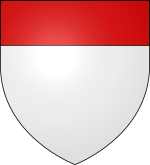Alan Durward facts for kids
Quick facts for kids Alan de LundinAlan Durward |
|
|---|---|
[[File: |frameless|Coat of arms: Argent, a chief Gules]] |frameless|Coat of arms: Argent, a chief Gules]] |
|
| Coat of arms: Argent, a chief Gules | |
| Spouse(s) | Isabella, Countess of Atholl Marjorie, daughter of King Alexander II of Scotland |
| Issue | |
| Ermenguarde de Lundin Anne de Durward Daughter (name unknown) Thomas Durward (illegitimate) |
|
| [[]] | de Lundin |
| Father | Thomas de Lundin |
| Mother | daughter of Máel Coluim, Earl of Atholl |
| Died | after c. 1264 |
Alan Hostarius (also known as Alan Durward) was a very important person in 13th-century Scotland. He was born after 1264 and died in 1275. His father was Thomas de Lundin, and his grandfather was Gille Críst, an early Scottish earl. Alan's mother was likely a daughter of Máel Coluim, another powerful earl. This means Alan came from two very important noble families in Scotland.
Alan was so influential that he actually helped rule Scotland at different times. This happened when King Alexander III was still a young boy. Alan inherited a special job from his father called hostarius. This role meant he was in charge of protecting the king's property.
Contents
Alan Durward: A Powerful Scottish Leader
Alan Durward played a huge role in Scottish politics during the 1200s. He was known for his leadership and his efforts to keep the kingdom stable. His actions helped shape Scotland's future.
Early Life and Important Roles
Alan likely took part in putting down a rebellion in 1228–29. This showed his early involvement in protecting the kingdom. By 1233, Alan was given control of Urquhart Castle near Loch Ness. He was probably responsible for building the first version of this castle. It was a type of castle called a motte, which was a wooden fort on a raised earth mound.
His Claim to the Earldom of Atholl
Around 1233 and 1235, Alan started calling himself "Count of Atholl." This was because his grandfather was an Earl of Atholl. Alan believed he should inherit this important title. King Alexander II seemed to agree with this claim for a short time.
However, by 1235, Alan stopped using the title "count." He never became an earl. Alan also tried to challenge the rights of the Earls of Mar. He was related to an earlier Earl of Mar, Gille Críst. But another family line had taken control of the earldom. Alan tried to remove Uilleam from his title but failed. Not becoming an earl was one of Alan's biggest disappointments.
Rivalries and Later Years
Alan Durward's career was marked by a strong rivalry with the Comyn family. This was a major conflict that affected the whole country. It was a big power struggle between two important groups.
Towards the end of his life, things seemed to get better between them. Alan was made a top legal official, called Justiciar of Scotia. He shared this role with Alexander Comyn, Earl of Buchan, who was a Comyn. They even worked together on two military trips against the Norwegians. Alan also witnessed one of Earl Alexander's official documents in 1272.
Alan spent many of his later years in England. He tried to get the support of King Henry III of England. This was during the time when Alexander III was young and Alan wanted to stay in power. The English king even gave Alan his own large estate in England called Bolsover.
Alan Durward passed away in 1275. He was buried at the abbey of Coupar Angus.
Family
Alan married Marjory, who was a daughter of King Alexander II. They had three children:
- Ermengarde, who married William I de Soules, the king's butler.
- Anne Durward, who married Colbán, Earl of Fife first. Later, she married Sir William de Ferrers.
- A daughter whose name is not known, who married John Bisset.
Alan also had at least one son born outside of marriage, named Thomas Durward. None of Alan's children became as politically famous as their father.

